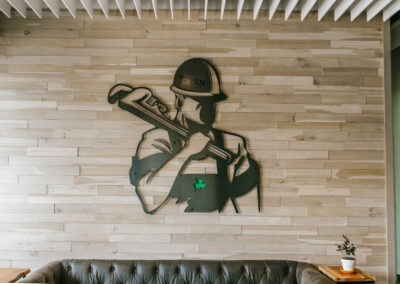Have you ever wondered how drinking water is separated from the water in sprinkler systems and pipes? The difference is potable (treated, drinking quality) vs. non-potable (untreated, not fit for drinking) water, and backflow preventers are responsible for keeping potable water clean and free of contaminants.
 The purpose of a backflow prevention device is to prevent the water utilized in a building’s water systems (which may contain contaminants such as fertilizer and pesticides) from backing up and entering into drinking water. This can include the domestic water system, the irrigation system and the fire sprinkler system. All water companies require that backflow preventers be tested regularly and maintained by certified professionals to ensure they are reliable and functioning properly.
The purpose of a backflow prevention device is to prevent the water utilized in a building’s water systems (which may contain contaminants such as fertilizer and pesticides) from backing up and entering into drinking water. This can include the domestic water system, the irrigation system and the fire sprinkler system. All water companies require that backflow preventers be tested regularly and maintained by certified professionals to ensure they are reliable and functioning properly.
Types of Backflow Preventers
There are many types of backflow preventers and each has specific applications. While the testing for each type generally remains the same, the most common assemblies are:
- Reduced Pressure Zones (RPZ): Primarily intended for plumbing and other internal systems, RPZs are the most complex and reliable backflow preventers. These devices consist of a shutoff valve, two spring-loaded check valves separated by a pressure differential relief valve, four test cocks, and an outlet shutoff valve.
- Double Check Valves (DCV): As the most common type of approved backflow prevention device, DCVs consist of an inlet shutoff valve, two independently operating spring-loaded check valves (usually inside a single valve body), four test cocks, and an outlet shutoff valve. DCVs are specifically designed to prevent backflow in fire sprinkler systems.
- Pressure Vacuum Breakers (PVB): Pressure vacuum breaker assemblies (PVBs) are the most inexpensive type of whole-system backflow preventer and are intended for lawn irrigation. PVBs are relatively simple in design, and are easy to install, maintain and repair.
Backflow Testing
Scheduled testing of backflow assemblies is essential for code compliance and safety. A routine backflow test consists of attempting to remove water from a backflow assembly and usually takes 15 minutes to perform. While the frequency of testing varies between jurisdictions, it is expected to be tested annually at a minimum. These system tests are critical to ensure potable water is safe to drink.
Due to the inherent risk of contaminated water, a backflow assembly only delivers pass or fail results – there is no middle ground. If ANY water escapes the backflow assembly, it fails. If a device fails the test, it should be repaired or replaced immediately. Solutions for failed backflow assemblies can vary in scope and costs, but can be as simple as replacing o-rings and rubber gaskets.
To have a Ryan Fireprotection professional conduct inspection and testing services on your backflow assembly, please fill out our contact us form, or call 1.800.409.7606, and press 1 to be connected to our service department.

